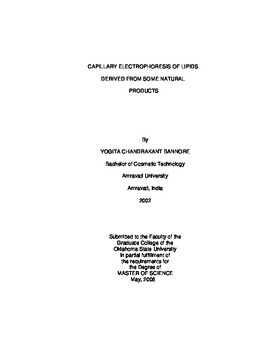| dc.contributor.advisor | Rassi, Ziad El | |
| dc.contributor.author | Bannore, Yogita Chandrakant | |
| dc.date.accessioned | 2014-03-14T21:53:34Z | |
| dc.date.available | 2014-03-14T21:53:34Z | |
| dc.date.issued | 2008-05-01 | |
| dc.identifier.uri | https://hdl.handle.net/11244/8075 | |
| dc.description.abstract | The purpose of this study was to develop capillary electrophoresis methods for the analysis of some lipids, namely free fatty acids and phospholipids in food produces such as peanut seeds and watermelon, respectively. In the case of peanuts, the free fatty acids from single peanut seeds were extracted and then analyzed for their content of oleic acid and linoleic acid using a partially aqueous electrolyte based on N-methylformamide, dioxane and low water content in the presence of small amounts of -cyclodextrin as the selectivity modulator. The capillary electrophoresis system, thus developed was coupled with an indirect UV detection mode using adenosine monophosphate as the UV absorber. In the case of watermelon, the slightly modified and partially aqueous capillary electrophoresis system developed for free fatty acid analysis was successfully applied for the analysis of phospholipids extracted from watermelon fruit.\nFindings and Conclusions: This investigation showed that a partially aqueous capillary electrophoresis method coupled with an indirect UV detection could be readily applied for the separation and determination of some lipids in food matrices. Free fatty acids analysis of several samples from two major peanut breeding lines was successfully achieved. This was facilitated by incorporating cyclodextrin, a cyclic oligosaccharide, in the running electrolyte, which modified the separation selectivity of the fatty acids, thus allowing their full separation within 25 min. The capillary electrophoresis method allowed the rapid screening of high oleic acid peanuts from low oleic acid peanuts. Using a slightly modified and partially aqueous electrolyte system at lower water content devoid of cyclodextrin allowed the separation and determination of some phospholipids in watermelon within 8 min. These capillary electrophoresis methods are expected to be of general use in the analysis of free fatty acids and phospholipids extracted from other natural products. | |
| dc.format | application/pdf | |
| dc.language | en_US | |
| dc.publisher | Oklahoma State University | |
| dc.rights | Copyright is held by the author who has granted the Oklahoma State University Library the non-exclusive right to share this material in its institutional repository. Contact Digital Library Services at lib-dls@okstate.edu or 405-744-9161 for the permission policy on the use, reproduction or distribution of this material. | |
| dc.title | Capillary Electrophoresis of Lipids Derived from Some Natural Products | |
| dc.type | text | |
| dc.contributor.committeeMember | Lavine, Barry K. | |
| dc.contributor.committeeMember | Melouk, Hassan A. | |
| osu.filename | Bannore_okstate_0664M_10568.pdf | |
| osu.college | Arts and Sciences | |
| osu.accesstype | Open Access | |
| dc.description.department | Chemistry Department | |
| dc.type.genre | Thesis | |
